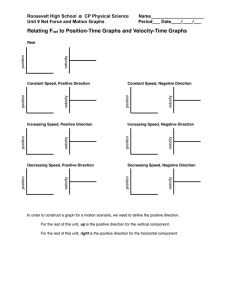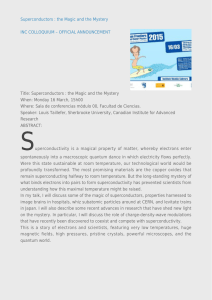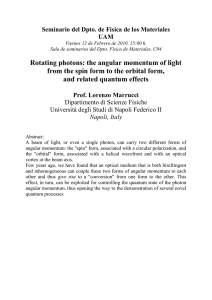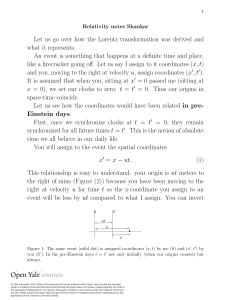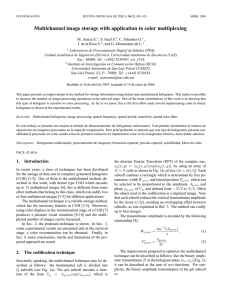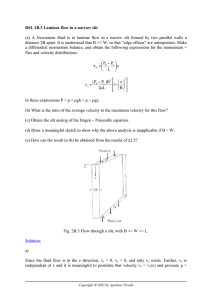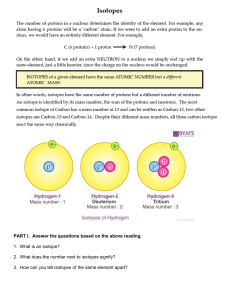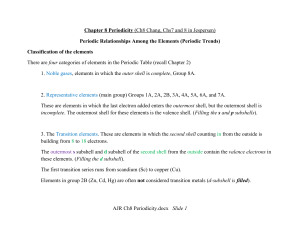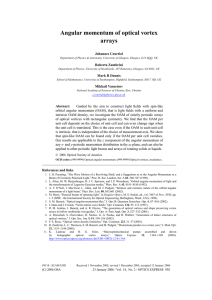Introduction of the concepts of hole and effective mass using an
Anuncio
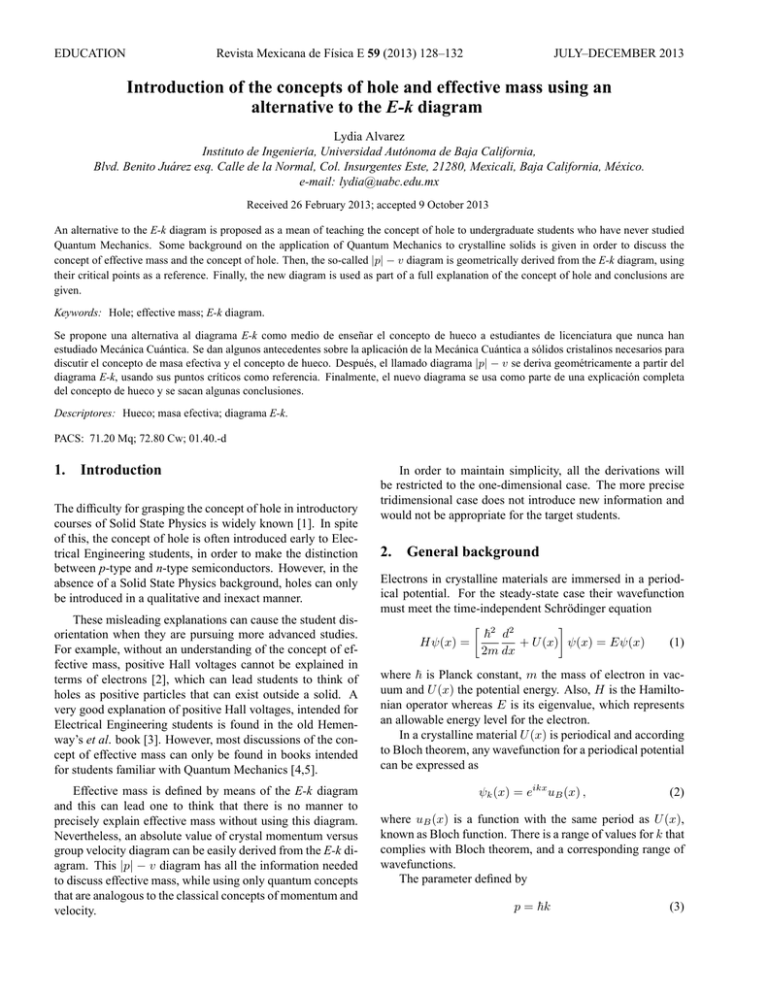
EDUCATION Revista Mexicana de Fı́sica E 59 (2013) 128–132 JULY–DECEMBER 2013 Introduction of the concepts of hole and effective mass using an alternative to the E-k diagram Lydia Alvarez Instituto de Ingenierı́a, Universidad Autónoma de Baja California, Blvd. Benito Juárez esq. Calle de la Normal, Col. Insurgentes Este, 21280, Mexicali, Baja California, México. e-mail: [email protected] Received 26 February 2013; accepted 9 October 2013 An alternative to the E-k diagram is proposed as a mean of teaching the concept of hole to undergraduate students who have never studied Quantum Mechanics. Some background on the application of Quantum Mechanics to crystalline solids is given in order to discuss the concept of effective mass and the concept of hole. Then, the so-called |p| − v diagram is geometrically derived from the E-k diagram, using their critical points as a reference. Finally, the new diagram is used as part of a full explanation of the concept of hole and conclusions are given. Keywords: Hole; effective mass; E-k diagram. Se propone una alternativa al diagrama E-k como medio de enseñar el concepto de hueco a estudiantes de licenciatura que nunca han estudiado Mecánica Cuántica. Se dan algunos antecedentes sobre la aplicación de la Mecánica Cuántica a sólidos cristalinos necesarios para discutir el concepto de masa efectiva y el concepto de hueco. Después, el llamado diagrama |p| − v se deriva geométricamente a partir del diagrama E-k, usando sus puntos crı́ticos como referencia. Finalmente, el nuevo diagrama se usa como parte de una explicación completa del concepto de hueco y se sacan algunas conclusiones. Descriptores: Hueco; masa efectiva; diagrama E-k. PACS: 71.20 Mq; 72.80 Cw; 01.40.-d 1. Introduction The difficulty for grasping the concept of hole in introductory courses of Solid State Physics is widely known [1]. In spite of this, the concept of hole is often introduced early to Electrical Engineering students, in order to make the distinction between p-type and n-type semiconductors. However, in the absence of a Solid State Physics background, holes can only be introduced in a qualitative and inexact manner. These misleading explanations can cause the student disorientation when they are pursuing more advanced studies. For example, without an understanding of the concept of effective mass, positive Hall voltages cannot be explained in terms of electrons [2], which can lead students to think of holes as positive particles that can exist outside a solid. A very good explanation of positive Hall voltages, intended for Electrical Engineering students is found in the old Hemenway’s et al. book [3]. However, most discussions of the concept of effective mass can only be found in books intended for students familiar with Quantum Mechanics [4,5]. Effective mass is defined by means of the E-k diagram and this can lead one to think that there is no manner to precisely explain effective mass without using this diagram. Nevertheless, an absolute value of crystal momentum versus group velocity diagram can be easily derived from the E-k diagram. This |p| − v diagram has all the information needed to discuss effective mass, while using only quantum concepts that are analogous to the classical concepts of momentum and velocity. In order to maintain simplicity, all the derivations will be restricted to the one-dimensional case. The more precise tridimensional case does not introduce new information and would not be appropriate for the target students. 2. General background Electrons in crystalline materials are immersed in a periodical potential. For the steady-state case their wavefunction must meet the time-independent Schrödinger equation ¸ · 2 2 ~ d + U (x) ψ(x) = Eψ(x) (1) Hψ(x) = 2m dx where ~ is Planck constant, m the mass of electron in vacuum and U (x) the potential energy. Also, H is the Hamiltonian operator whereas E is its eigenvalue, which represents an allowable energy level for the electron. In a crystalline material U (x) is periodical and according to Bloch theorem, any wavefunction for a periodical potential can be expressed as ψk (x) = eikx uB (x) , (2) where uB (x) is a function with the same period as U (x), known as Bloch function. There is a range of values for k that complies with Bloch theorem, and a corresponding range of wavefunctions. The parameter defined by p = ~k (3) INTRODUCTION OF THE CONCEPTS OF HOLE AND EFFECTIVE MASS USING AN ALTERNATIVE TO THE E-K DIAGRAM is known as crystal momentum because it is related to the external applied force by Fexternal = dp , dt (4) which is a relation analogous to Newton’s second law. A positive force will be associated with an increase of crystal momentum, whereas a negative force with a decrease of crystal momentum. It is important to note that this behavior is not dependent on the particle being positive or negative. Because of the wavelike properties of electrons, the only velocity that can be defined for them is the group velocity of a wavefunction package formed by the neighboring wavefunctions. That is ¯ 1 dE ¯¯ vg = . (5) ~ dk ¯k 129 Nevertheless, students without a background in Quantum Mechanics will find the E − k diagram meaningless and its introduction will not be useful in any way. An option is to attempt to give the student a review of Quantum basics before the concept of hole is introduced. This approach will consume class time and may even not be enough to solve the problem. A better alternative is to turn to the use of the |p|−v diagram, the derivation of which is described as follows. Crystal momentum and group velocity are concepts analogous to classical momentum and velocity and can be used to define a concept analogous to mass, that is, effective mass. Effective mass definition is ¯ dp ¯¯ ∗ , (6) m = dv ¯v which can also be expressed as m∗ = ¯ ¯ ~2 ¯ . 2 2 d E/dk ¯k (7) F IGURE 2. Basic sketch of a group velocity versus crystal momentum diagram, obtained from the derivative of the E-k diagram. The standard manner to manage these concepts in Solid State Physics is by plotting the eigenvalues E of the wavefunctions versus the parameter k. This is an E − k diagram, like that shown in Fig. 1. The dynamics of the electron in the crystalline lattice are fully contained in this diagram. The crystal momentum, related to the parameter k, can be obtained from the abscise axis whereas the group velocity and effective mass can be extracted from the slope and concavity of the plot, respectively. In the context of a course on Solid State Physics for students who are knowledgeable in Quantum Mechanics, the E − k diagram is irreplaceable. F IGURE 3. Basic sketch of a crystal momentum versus group velocity diagram, obtained by switching the axes in Fig. 2. F IGURE 1. Basic sketch of an E-k diagram. Rev. Mex. Fis. E 59 (2013) 128–132 130 3. LYDIA ALVAREZ 4. Diagram derivation Regardless of the actual form of the periodical potential, all the E-k diagrams share many characteristics, like mirror symmetry and zero slope at k = 0. For the positive half, the slope increases with increasing k until it reaches a maximum, and then it decreases until reaching zero again at the boundary of the first Brilloin zone at k = π/a. The five critical points can be easily spotted on the typical E − k diagram, shown in Fig. 1. From the critical points of the E − k diagram, to sketch its derivative is straightforward, and the result is shown in Fig. 2. The abscise and ordinate axes have also been multiplied and divided respectively by the Planck constant so that they correspond to crystal momentum and group velocity. According to Eq. (6) the derivative of this plot must be the reciprocal of effective mass, which can be verified by µ d 1 dE ~ d(~k) ¶ = 1 d2 E . ~2 dk 2 (8) If the axes are interchanged, the slope will be the effective mass, as in Fig. 3. However, this diagram is problematic because the mirror symmetry of the E − k diagram is lost and energy bands are split. It is convenient to take the absolute value of this plot, as it has been done in Fig. 4, even when now, only the right half of the plot will have a correspondence between slope and effective mass. This is the |p| − v diagram that can be used as an alternative to the E − k diagram to explain effective mass and the concept of hole. From Eq. (4), a positive force will tend to increase the crystal momentum of the particle, while a negative force will have the opposite effect. It can be noted that a particle moving counterclockwise in the |p|−v diagram is increasing crystal momentum whereas one moving clockwise is decreasing crystal momentum. In practice, particles will never cycle the entire |p| − v diagram because of scattering, but they will still tend to move in that direction. Introducing the |p| − v diagram The first |p| − v diagram to be presented to students is in Fig. 5. This is the |p| − v diagram of a classical particle, which the student should find obvious. The slope in the right half of the plot is constant, like the mass of a classical particle is supposed to be. The presentation of this diagram has the purpose of making smoother the transition to more complicate concepts. The second |p| − v diagram that the students should address is in Fig. 6. This is the |p| − v diagram of a relativistic particle. The slope in the right half of the plot is the relativistic mass [6] rather than the constant mass defined by particle physicists [7]. This is convenient since relativistic mass is increased as the velocity of the particle is increased and it grows asymptotically to infinite. This concept will help to introduce the student to the idea of a variable mass. Finally, |p| − v diagram of Fig. 4 should be introduced, calling it a Solid State |p| − v diagram. The students should be invited to accept the diagram in Fig. 4 as a consequence of Quantum Mechanics applied to a crystalline material, in the same manner as they already accepted the diagram in Fig. 6 F IGURE 5. A classical |p| − v diagram. F IGURE 4. Solid state |p| − v diagram. F IGURE 6. A relativistic |p| − v diagram. Rev. Mex. Fis. E 59 (2013) 128–132 INTRODUCTION OF THE CONCEPTS OF HOLE AND EFFECTIVE MASS USING AN ALTERNATIVE TO THE E-K DIAGRAM 131 as a consequence of Relativity Theory. This is a good argument in favor of the usefulness of the relativistic mass for teaching basic concepts [8]. This simple approach will skip the introduction of Quantum Mechanics concepts, without sacrificing rigor. The students will be able to clarify in more advanced studies the real meaning of group velocity, crystal momentum and effective mass, when they are in conditions to find a meaning in such a clarification. 5. Using the diagram to explain the concept of hole The explanation of the concept of hole found below, was based on that in Hemenway et al. book [3], although the |p| − v diagram is used instead of the E − k diagram. Since the |p| − v diagram only needs axes and slopes for parameter extraction, it is expected that the connection between verbal explanations and visual illustrations will be easier for the students. For the sake of simplicity, momentum, velocity and mass will be used in place of crystal momentum, group velocity and effective mass, without further explanation. At temperatures higher than absolute zero, all particles are always moving and electrons in a solid are not an exception. However, this movement is not associated with an electrical current unless electrons move as a group and their net velocity is different from zero. In Fig. 7, the velocity of the electrons can be extracted from their position in the abscise axis. Electrons in the righthalf of the plot have positive velocities and those in the lefthalf have negative velocities. If the band is completely filled, the positive velocities will cancel out the negative velocities giving a net velocity of zero. Therefore, electrons in a filled band cannot participate in an electrical current. Even if the band is not completely filled, there will not be an electrical current if there is not an electric field for drifting the electrons. Electrons will occupy the lower positions in the |p| − v diagram in a symmetrical manner as shown in the almost empty band of Fig. 8. It can be seen that positive velocities cancel out negative velocities as before. F IGURE 7. Solid state |p| − v diagram: filled band. F IGURE 8. Solid state |p| − v diagram: almost empty band, no electric field. F IGURE 9. Solid state |p|−v diagram: almost empty band, positive electric field. In Fig. 9 a positive force will make the electrons go counterclockwise. However, because of scattering, the result will be a stationary state with more electrons in the right-half of the plot than in the left-half, giving a positive net velocity. Since electrons are negative, the electrical current will be negative. Also, the positive force must have been originated by a negative electric field, as sketched also in Fig. 9. Again in Fig. 9, only the electrons in black are relevant to the current, and the slope of the plot shows they have a positive mass. Nevertheless, their mass is not the same as they would have in vacuum. The slope of the |p| − v diagram and, therefore, the mass of the electrons, is different for different materials and even for different bands inside the same material. These are called effective masses and their experimental values should be consulted in reference tables. Figure 10 is similar to Fig. 9 with the exception that the band is almost filled. The electrons still go counterclockwise and have a positive net velocity giving rise to a negative electric current. However, there is an important difference: the slope of the plot, and therefore the mass of the electrons, are now negative. Rev. Mex. Fis. E 59 (2013) 128–132 132 LYDIA ALVAREZ F IGURE 10. Solid state |p|−v diagram: almost filled band, positive electric field. same negative current as the electrons they are replacing, holes must be regarded as positive particles. Because of this, a negative electric field would give rise to a negative force and holes would tend to go clockwise in the |p| − v diagram. Holes have an effective mass that is negative to that of the electrons they are replacing, so holes in Fig. 11 have a positive effective mass. This can be verified by inspection of the |p| − v diagram: they are decreasing momentum when they decrease velocity. As a matter of fact, the effective mass of holes can be extracted from the slope of the left-half of the |p| − v diagram in the same manner as the effective mass of electrons can be extracted from slope of the right-half of the |p| − v diagram. In summary, electrons in almost empty bands have a positive effective mass which does not represent a problem. They are called “electrons” and their masses are obtained from tables depending on the material they are immersed. On the other hand, electrons in almost filled bands have a negative effective mass and that it is seen as a problem. They are treated as positive particles with a positive effective mass and called “holes”. 6. F IGURE 11. Solid state |p|−v diagram: almost filled band, positive electric field. Holes. In order to spare the concept of a negative mass, almost filled bands are treated differently from almost empty bands. In almost filled bands, electrons are not counted but, instead, the energy levels that are not occupied by electrons are counted. These non-occupied energy levels are called holes. Holes are drawn in Fig. 11 as open circles, and those relevant to the electrical current as thick open circles. The holes relevant to current are in the left-half, so they have a negative velocity. In order for them to represent the 1. B.S. Chandrasekhar, Am. J. Phys. 63 (1995) 853. 2. R.C. Cross, Am. J. of Phys. 46 (1976) 771. 3. C. Hemenway, R. Henry and M. Caulton, Physical Electronics (2nd Edition. Wiley, 1967). 4. C. Kittel, Introduction to Solid State Physics (8th Edition, Wiley, 2004). Conclusion Although necessary for telling p-type and n-type materials apart, the concept of hole is difficult to understand for students not conversant with Quantum Mechanics. The risk of distorting the concept when trying to make it simpler is high, and this can compromise the ability of an Electrical Engineering student to pursue further studies in device physics. Although the E-k diagram is meaningless for someone who does not know about wavefunctions, it is possible to derive a |p| − v diagram that uses only concepts that are analogous to those in classical physics: crystal momentum, group velocity and effective mass. The |p| − v diagram has the same information as the E − k diagram and can be used in the same manner to explain the behavior of electrons in a solid without going deep into its quantum meaning. This approach gives the student a sketchy but correct explanation of the relevant phenomena, which can be strengthened later in more advanced courses. 5. N.W. Ashcroft and N.D. Mermin, Solid State Physics (Brooks Cole, 1976). 6. C.G. Adler, Am. J. Phys. 55 (1987) 739. 7. J. Bernstein, Am. J. Phys. 79 (2011) 25. 8. T.R. Sandin, Am. J. Phys. 59 (1991) 1032. Rev. Mex. Fis. E 59 (2013) 128–132
